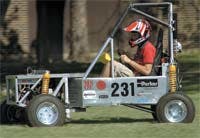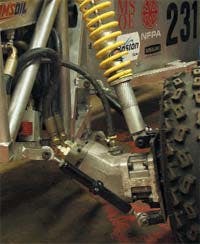Student project leads to innovative hydraulics
A 2002 design project by senior undergraduates at the Milwaukee School of Engineering (MSOE) makes extensive use of sophisticated hydraulics technology for an offroad vehicle in the Society of Automotive Engineers’ (SAE) annual Mini Baja Competition.
The contest simulates real-world engineering projects and related challenges for students to design and build an off-road vehicle that would survive the severe punishment of rough terrain. Students had to work as a team, not only to design, build, test, promote, and race a vehicle within the limits of the rules, but also to generate financial support for their project and manage their class loads as well. The competition includes rigorous tests of maneuverability, acceleration, top speed, braking, hill climbing, power pulling, and a four-hour endurance race.
A departure from tradition
MSOE has been involved in the competition for the last several years. However, this particular design represents a radical departure from the mechanically dominated power trains traditionally used. Instead of the conventional geared transmission, drive shafts, differential gearing, and transfer box for four-wheel drive, MSOE’s concept vehicle embraces hydrostatic drive technology with sophisticated electronics for performance and capabilities that clearly would be impractical for mechanical drives.
Key features of MSOE’s mini Baja include:
• hydrostatic transmission with energy management (load sensing, power limiting, and pressure compensation) at the pump,
• energy storage (via hydropneumatic accumulators) for speed boost on demand,
• selectable two- or four-wheel drive with maximum power utilization under all operating conditions — hill climb, acceleration, and power pull,
• front engine placement for nearly 50/50 weight distribution,
• articulated steering (via a hydraulic rotary actuator) for tight turning radius,
• CANbus control of electrohydraulic components, which allows vehicle performance to be adjusted based on track conditions, and
• electrohydraulic valve control of differential wheel speed, which permits full power while turning by eliminating skip and bounce.
The Baja car uses a wheel motor and front suspension setup often found mobile equipment. Tom Labus, P. E., professor of mechanical engineering, reveals, “This is one area where substantial improvement can be made in future designs by incorporating a small planetary gearbox with a high-speed motor to reduce the overall size and unsprung weight.”
An alternator installed on the engine provides electrical power to operate the controllers and electrohydraulic valves that control the power delivered to each motor. The electrohydraulic valves allow four-wheel drive while turning without causing the front end to bounce or skip through the turn. This control, combined with articulated steering, provided an advantage in the maneuverability portion of the competition.
The rear suspension arms reach to the center of the vehicle, and the trailing arms also extend to near the center of the rear section of the car. This provides little change in wheel camber through the entire stroke of the suspension.
An ongoing project
Simulation has revealed especially useful information on vehicle speed vs. distance to check performance for the acceleration, top speed, and braking competition. It also provides key information on system efficiency vs. vehicle speed to ensure suitable performance over the operating range for the competition. Consequently, work on the vehicle is continuing to:
• improve overall transmission efficiency and reduce its weight,
• revise the four-wheel steering based at each wheel to reduce weight, and
• enhance energy storage with lighter weight accumulators.
For more information, contact Tom Labus at [email protected].






